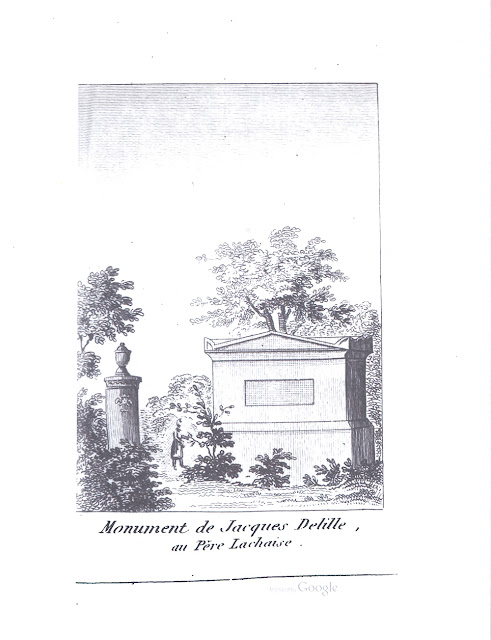Sunday, December 29, 2013
Wednesday, December 25, 2013
Sunday, December 22, 2013
Wednesday, December 18, 2013
Sunday, December 15, 2013
Wednesday, December 11, 2013
Sunday, December 08, 2013
Poste Gambetta entrance to Pere-Lachaise - postcard
Located on the northeastern side of the cemetery Porte Gambetta is the terminus of avenue du Pere-Lachaise and is the other major entrance (after Porte Principale off of boulevard Menilmontant). You can just make out the crematorium and columbarium in the background.
Notice the changes in the gate structure? Which is the older of the two? My money is on the bottom one
Notice the changes in the gate structure? Which is the older of the two? My money is on the bottom one
Labels:
entrance,
Pere Lachaise,
Pere-Lachaise,
Porte Gambetta,
postcard
Wednesday, December 04, 2013
Sunday, December 01, 2013
Rue de la Roquette to Pere-Lachaise - postcard
You're looking east toward the cemetery, which gates you can make out at the far end of the street. The cafe nearest to you and to the left is still a cafe today -- a great place for lunch.
Labels:
Pere Lachaise,
Pere-Lachaise,
postcard,
rue de la Roquette
Wednesday, November 27, 2013
Heloise and Abelard prints in division 7
 |
| note the old maison on the hill; abandoned and neglected it was replaced in 1823 by the present chapel |
 |
| 1828 |
 |
| 1832 Normand |
 |
| 1832 Quaglia |
 |
| 1836 |
 |
| 1840 |
Labels:
Abelard,
division 7,
Heloise,
Pere-Lachaise,
print
Sunday, November 24, 2013
Ney in division 29 - postcard
Following his execution for supporting Napoleon's final return and loss of power, near the Jardin du Luxembourg on December 7, 1815, Michel Ney was quietly interred beneath a simple slab at the eastern extreme of the cemetery, in what is today division 44 grave.
His body was eventually moved to a much more elaborate tomb in division 29, near some of France's greatest military heroes: Lefebvre, Massena, Decres, Gobert, Ruty, and numerous other other generals and marshals.
His body was eventually moved to a much more elaborate tomb in division 29, near some of France's greatest military heroes: Lefebvre, Massena, Decres, Gobert, Ruty, and numerous other other generals and marshals.
Labels:
division 29,
Ney,
Pere Lachaise,
Pere-Lachaise,
postcard
Wednesday, November 20, 2013
Sunday, November 17, 2013
Wednesday, November 13, 2013
Wednesday, November 06, 2013
Wednesday, October 30, 2013
Wednesday, October 23, 2013
Saturday, October 19, 2013
New Field Guide to Paris Cemeteries
In 2012 the official Paris city website reported that more than two million people visit Pere-Lachaise Cemetery. TripAdvisor, one of the most popular travel websites, recently ranked Pere-Lachaise as the 30th most popular of 616 Paris attractions reported by reviewers. Yet the absence of an English-language guide to Paris cemeteries has been a serious gap in travel resources for the City of Light.
The few English-language books on the subject have been either singularly focused on one cemetery or theme with little helpful information or self-indulgent exercises in how not to help travelers find their way through the maze of Parisian dead. In fact, not since 1986, when Judi Culbertson and Tom Randall produced their engaging but rather flawed Permanent Parisians, has anyone thought to write a serious work on the cemeteries of Paris.
Until now.
Doug Keister's Stories in Stone Paris: A Guide to Paris Cemeteries (Gibbs Smith 2013) is packed full of handy information, fascinating stories and a wealth of detail neatly arranged and easy to use. He has also put Parisian burial practices in perspective with his seminal work on funeral symbology -- a nice addition as well.
I first discovered Doug Keister's work on cemeteries in 2006 when I came across a friend's copy of Stories in Stone: A Field Guide to Cemetery Symbolism and Iconography. It quickly became my primary resource whenever I had a question about the unusual, enlightening and often arcane symbols found on tombstones. Stories in Stone is one of those critical guidebooks that any serious cemetery traveler must have in her library. Keister's grasp of his subject was matched by his engaging writing style and thoroughness of research.
Keister's initial field guide was followed up by the successful and equally fascinating Stories in Stone: A Field Guide to New York City Area Cemeteries & Their Residents. And now he has crossed the Atlantic to bring us his unique skill for finding the interesting and unusual in the cemeteries of Paris.
Relying on the expertise and invaluable assistance of local Paris cemetery expert Marie Beleyme, Keister's latest guide provides the traveler with an easy-to-use, very readable guide to the major Paris cemeteries. While one hopes to eventually see separate English-language guides to the Paris Big Three (Pere-Lachaise, Montparnasse and Montmartre), for the time being this work must be the English-language resource of record.
(Disclaimer: this reviewer is listed as a resource in Keister's Stories in Stone Paris: A Guide to Paris Cemeteries. He makes no apologies, however, knowing first-hand that Keister remains committed to being as accurate, helpful and informative as possible.)
Wednesday, October 16, 2013
Subscribe to:
Posts (Atom)











































